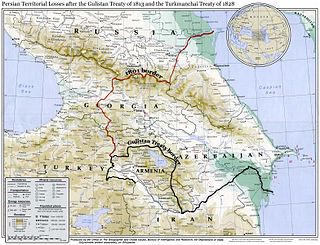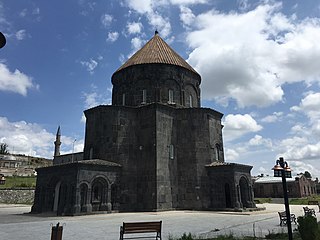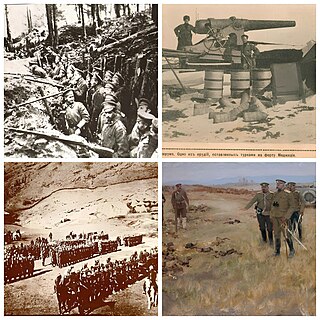| |||||
| Decades: | |||||
|---|---|---|---|---|---|
| See also: | Other events of 1918 List of years in Armenia | ||||
The following lists events that happened during 1918 in Armenia .
| |||||
| Decades: | |||||
|---|---|---|---|---|---|
| See also: | Other events of 1918 List of years in Armenia | ||||
The following lists events that happened during 1918 in Armenia .

The Transcaucasian Socialist Federative Soviet Republic, also known as the Transcaucasian Soviet Federative Socialist Republic, or simply Transcaucasia, was a republic of the Soviet Union that existed from 1922 to 1936.

The Democratic Republic of Georgia was the first modern establishment of a republic of Georgia, which existed from May 1918 to February 1921. Recognized by all major European powers of the time, DRG was created in the wake of the Russian Revolution of 1917, which led to the collapse of the Russian Empire and allowed territories formerly under Russia's rule to assert independence. In contrast to Bolshevik Russia, DRG was governed by a moderate, multi-party political system led by the Georgian Social Democratic Party (Mensheviks).

The Treaty of Gulistan was a peace treaty concluded between the Russian Empire and Qajar Iran on 24 October 1813 in the village of Gulistan as a result of the first full-scale Russo-Persian War. The peace negotiations were precipitated by the successful storming of Lankaran by General Pyotr Kotlyarevsky on 1 January 1813. It was the first of a series of treaties signed between Qajar Iran and Imperial Russia that forced Persia to cede the territories that formerly were part of Iran.

Kars is a city in northeast Turkey. It is the seat of Kars Province and Kars District. As of 2022, its population was 91,450. Kars, in classical historiography (Strabo), was in the ancient region known as Chorzene, part of the province of Ayrarat in the Kingdom of Armenia, and later the capital of the Bagratid Kingdom of Armenia from 929 to 961. Currently, the mayor of Kars is Türker Öksüz. The city had an Armenian ethnic majority until it was re-captured by Turkish nationalist forces in late 1920.

The Transcaucasian Democratic Federative Republic was a short-lived state in the Caucasus that included most of the territory of the present-day Armenia, Azerbaijan and Georgia, as well as parts of Russia and Turkey. The state lasted only for a month before Georgia declared independence, followed shortly after by Armenia and Azerbaijan.

The Azerbaijan Democratic Republic, also known as the Azerbaijan People's Republic, was the first secular democratic republic in the Turkic and Muslim worlds. The ADR was founded by the Azerbaijani National Council in Tiflis on 28 May 1918 after the collapse of the Transcaucasian Democratic Federative Republic, and ceased to exist on April 28, 1920. Its established borders were with Russia to the north, the Democratic Republic of Georgia to the north-west, the Republic of Armenia to the west, and Iran to the south. It had a population of around 3 million. Ganja was the temporary capital of the Republic as Baku was under Bolshevik control. The name of "Azerbaijan" which the leading Musavat party adopted, for political reasons, was, prior to the establishment of the Azerbaijan Democratic Republic in 1918, exclusively used to identify the adjacent region of contemporary northwestern Iran.

The First Republic of Armenia, officially known at the time of its existence as the Republic of Armenia, was an independent Armenian state that existed from May 1918 to 2 December 1920 in the Armenian-populated territories of the former Russian Empire known as Eastern or Russian Armenia. The republic was established in May 1918, with its capital in the city of Yerevan, after the dissolution of the short-lived Transcaucasian Democratic Federative Republic. It was the first Armenian state since the Middle Ages.

The Caucasus campaign comprised armed conflicts between the Russian Empire and the Ottoman Empire, later including Armenia, Azerbaijan, Georgia, the Mountainous Republic of the Northern Caucasus, the German Empire, the Central Caspian Dictatorship, and the British Empire, as part of the Middle Eastern theatre during World War I. The Caucasus campaign extended from the South Caucasus to the Armenian Highlands region, reaching as far as Trabzon, Bitlis, Mush and Van. The land warfare was accompanied by naval engagements in the Black Sea.

The Treaty of Batum was signed in Batumi on 4 June 1918, between the Ottoman Empire and the three Transcaucasian states: the First Republic of Armenia, the Azerbaijan Democratic Republic and the Democratic Republic of Georgia. It was the first treaty of the First Republic of Armenia and the Azerbaijan Democratic Republic and had 14 articles.

The Armenian-Azerbaijani war (1918–1920) was a conflict that took place in the South Caucasus in regions with a mixed Armenian-Azerbaijani population, broadly encompassing what are now modern-day Azerbaijan and Armenia. It began during the final months of World War I and ended with the establishment of Soviet rule.

The Battle of Baku took place in August and September 1918 between the Ottoman–Azerbaijani coalition forces led by Nuri Pasha and Bolshevik–ARF Baku Soviet forces, later succeeded by the British–Armenian–White Russian forces led by Lionel Dunsterville and saw Soviet Russia briefly re-enter the war. The battle took place during World War I, was a conclusive part of the Caucasus Campaign, but a beginning of the Armenian–Azerbaijani War.
The Treaty of Poti was a bilateral agreement between the German Empire and the Democratic Republic of Georgia in which the latter accepted German protection and recognition. The agreement was signed, on 28 May 1918, by General Otto von Lossow for Germany and by Foreign Minister Akaki Chkhenkeli for Georgia. Concluded at the Georgian Black Sea port of Poti, the treaty came only two days after Georgia proclaimed independence, becoming the newly independent republic's first-ever international treaty.

The German Caucasus expedition was a military expedition sent in late May 1918, by the German Empire to the formerly Russian Transcaucasia during the Caucasus Campaign of World War I. Its prime aim was to stabilize the pro-German Democratic Republic of Georgia and to secure oil supplies for Germany by preventing the Ottoman Empire from gaining access to the oil reserves near Baku on the Absheron Peninsula.

The Kars oblast was a province (oblast) of the Caucasus Viceroyalty of the Russian Empire between 1878 and 1917. Its capital was the city of Kars, presently in Turkey. The oblast bordered the Ottoman Empire to the west, the Batum Oblast to the north, the Tiflis Governorate to the northeast, and the Erivan Governorate to the east. The Kars oblast included parts of the contemporary provinces of Kars, Ardahan, and Erzurum Province of Turkey, and the Amasia Community of the Shirak Province of Armenia.

The history of the Caucasus region may be divided by geography into the history of the North Caucasus (Ciscaucasia), historically in the sphere of influence of Scythia and of Southern Russia, and that of the South Caucasus in the sphere of influence of Persia, Anatolia, and Assyria.

The Trebizond Peace Conference was a conference held between 14 March and 13 April 1918 in Trebizond between the Ottoman Empire and a delegation of the Transcaucasian Diet and government. The opening session was on 14 March 1918. The representatives were Rear-Admiral Hüseyin Rauf Bey for the Ottoman Empire, and Akaki Chkhenkeli, Khalil bey Khasmammadov, Alexander Khatisian etc. as the Transcaucasian delegation.

The Batum oblast was a province (oblast) of the Caucasus Viceroyalty of the Russian Empire, with the Black Sea port of Batum as its administrative center. The Batum oblast roughly corresponded to most of present-day southwestern Georgia, and part of the Artvin Province of Turkey.

The Azerbaijan–Turkey border is a short 17 km (11 mi) long international border between the Republic of Azerbaijan and the Republic of Turkey. The border is located at the southeastern tip of the Iğdır Province on the Turkish side and at the northwestern tip of the Nakhchivan Autonomous Republic on the Azerbaijani side; running entirely along the Aras river, it is the shortest border for both countries.

The Armenia–Turkey border is 311 km in length and runs from the tripoint with Georgia in the north to the tripoint with Azerbaijan in the south. The land border has been closed since 3 April 1993. The border has been protected by guards of the Russian Federal Security Service since 1992. On 9 May 2024, Russian Presidential spokesman Dmitry Peskov announced that Russian border guards will continue to serve on Armenia's borders with Turkey and Iran, at the request of the Armenian side. The border is set to reopen for diplomats and citizens of third countries in 2023.

The Kagizman okrug was a district (okrug) of the Kars Oblast of the Russian Empire, existing between 1878 and 1918. Its capital was the town of Kagyzman, presently in the Kars Province of Turkey. The okrug bordered with the Kars okrug to the north, the Olti okrug to the northwest, the Erivan Governorate to the east, and the Erzurum Vilayet of the Ottoman Empire to the west.